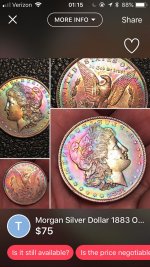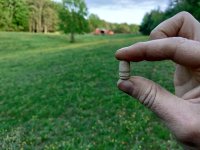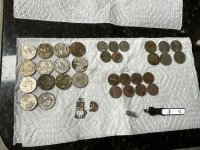You are using an out of date browser. It may not display this or other websites correctly.
You should upgrade or use an alternative browser.
You should upgrade or use an alternative browser.
Rainbow coins.
- Thread starter Holt0222
- Start date
Kantuckkeean
Bronze Member
- Apr 30, 2009
- 1,608
- 1,879
- Detector(s) used
- F-22, cheapo pinpointer
- Primary Interest:
- All Treasure Hunting
I’m not an expert but this topic came up a long while back and if my memory serves, some people were selling naturally toned coins at a premium (or at least trying to), which led to a bunch of folks artificially toning everything silver and marking them up so that they could try to make a few more bucks.
Kindest regards,
Kantuck
Kindest regards,
Kantuck
Diver_Down
Silver Member
It is toning of the silver. Many are faked using chemicals and even electrical current. For those that are real, they can fetch a hefty premium. The question is what is real? As a general rule, the more pronounced the rainbow, the more likely that it was manipulated/accelerated unnaturally.
Toning occurs naturally due to a reaction with the silver and environmental conditions. It was common that coins were stored in small manilla envelopes. These envelopes have a high sulfur content. If a coin is left in the envelope for a long period of time, the sulfur will react with the silver imparting a golden tone. That is just one example of how it occurs. Heat, Humidity, atmospheric impurities, storage, and environmental impurities can contribute to toning.
Some sellers will try to duplicate the process, but don't want to wait so they have to resort to using chemical solvents and other means to create the same effect. It is buyer beware. If it doesn't look right, then stay away.
P.S. Toning is not restricted to just silver planchets and even clad coins can tone. With clad, it is very rare to see rainbow toning. If toning does occur, it is likely to be a blue-hue to the toning. Whether it is residual solvents from the minting process along with storage/environmental factors, I'm not sure anyone will say for sure. Personally, I've had some beautiful clad dimes that were slabbed. Over time and I suspect elevated heat, they turned a beautiful blue tone. Sealed in the slab, one would expect it is immune from environmental impurities, but I suspect that the storage along with residual solvents from the minting process contributed to the toning. When I moved from PA to FL, I drove my Jeep with my coin collection stored inside and put the vehicle in storage. These outside storage units along with being locked in the Jeep, it had to been like an oven. After 2 months in storage, I moved the Jeep out of storage when I closed on my house. I didn't inspect every single coin, but rather moved them into the safe. After 15 years, I began clearing out the safe and selling some of the common stuff. A number of coins (nickels and dimes mostly) had turned varying shades blue. The three slabbed dimes are a steely-blue. I've had a roll of proof nickels and a few had toned while the majority were unchanged so it really is a hit or miss.
Toning occurs naturally due to a reaction with the silver and environmental conditions. It was common that coins were stored in small manilla envelopes. These envelopes have a high sulfur content. If a coin is left in the envelope for a long period of time, the sulfur will react with the silver imparting a golden tone. That is just one example of how it occurs. Heat, Humidity, atmospheric impurities, storage, and environmental impurities can contribute to toning.
Some sellers will try to duplicate the process, but don't want to wait so they have to resort to using chemical solvents and other means to create the same effect. It is buyer beware. If it doesn't look right, then stay away.
P.S. Toning is not restricted to just silver planchets and even clad coins can tone. With clad, it is very rare to see rainbow toning. If toning does occur, it is likely to be a blue-hue to the toning. Whether it is residual solvents from the minting process along with storage/environmental factors, I'm not sure anyone will say for sure. Personally, I've had some beautiful clad dimes that were slabbed. Over time and I suspect elevated heat, they turned a beautiful blue tone. Sealed in the slab, one would expect it is immune from environmental impurities, but I suspect that the storage along with residual solvents from the minting process contributed to the toning. When I moved from PA to FL, I drove my Jeep with my coin collection stored inside and put the vehicle in storage. These outside storage units along with being locked in the Jeep, it had to been like an oven. After 2 months in storage, I moved the Jeep out of storage when I closed on my house. I didn't inspect every single coin, but rather moved them into the safe. After 15 years, I began clearing out the safe and selling some of the common stuff. A number of coins (nickels and dimes mostly) had turned varying shades blue. The three slabbed dimes are a steely-blue. I've had a roll of proof nickels and a few had toned while the majority were unchanged so it really is a hit or miss.
dejapooh
Bronze Member
It is toning of the silver. Many are faked using chemicals and even electrical current. For those that are real, they can fetch a hefty premium. The question is what is real? As a general rule, the more pronounced the rainbow, the more likely that it was manipulated/accelerated unnaturally.
Toning occurs naturally due to a reaction with the silver and environmental conditions. It was common that coins were stored in small manilla envelopes. These envelopes have a high sulfur content. If a coin is left in the envelope for a long period of time, the sulfur will react with the silver imparting a golden tone. That is just one example of how it occurs. Heat, Humidity, atmospheric impurities, storage, and environmental impurities can contribute to toning.
Some sellers will try to duplicate the process, but don't want to wait so they have to resort to using chemical solvents and other means to create the same effect. It is buyer beware. If it doesn't look right, then stay away.
P.S. Toning is not restricted to just silver planchets and even clad coins can tone. With clad, it is very rare to see rainbow toning. If toning does occur, it is likely to be a blue-hue to the toning. Whether it is residual solvents from the minting process along with storage/environmental factors, I'm not sure anyone will say for sure. Personally, I've had some beautiful clad dimes that were slabbed. Over time and I suspect elevated heat, they turned a beautiful blue tone. Sealed in the slab, one would expect it is immune from environmental impurities, but I suspect that the storage along with residual solvents from the minting process contributed to the toning. When I moved from PA to FL, I drove my Jeep with my coin collection stored inside and put the vehicle in storage. These outside storage units along with being locked in the Jeep, it had to been like an oven. After 2 months in storage, I moved the Jeep out of storage when I closed on my house. I didn't inspect every single coin, but rather moved them into the safe. After 15 years, I began clearing out the safe and selling some of the common stuff. A number of coins (nickels and dimes mostly) had turned varying shades blue. The three slabbed dimes are a steely-blue. I've had a roll of proof nickels and a few had toned while the majority were unchanged so it really is a hit or miss.
My understanding is that since many of the Morgan Dollars around today were stored in government Vaults until the 1960's, the inks, and chemicals in the bags had a huge effect on the toning of coins. Where the coins were in the bag, and where the bag was in the stack could effect the atoms and molecules the silver was exposed to. Silver exposed to oxygen tones very different from Silver exposed to sulfur... You get the idea. Rainbow tones, while rare, do occur in the wild, typically, from my understanding, in coins that were stored for a long time in Paper Rolls, Mostly the enders, though, many from rolls would have a ring of black and rainbow toning around an original center. Toning is generally desirable because the chemical process of toning stabilizes the surface of the silver coin, and prevents a less attractive finish from taking hold. Modern "artificial Toning" will likely not offer that stability, since it is not Silver Oxide, silver sulfide, and other compounds in the surface of the coin, but rather a burned on surface (as most artificial toning uses heat to accelerate the process).
Top Member Reactions
-
 2310
2310 -
 1122
1122 -
 1041
1041 -
 898
898 -
 836
836 -
 770
770 -
 755
755 -
 739
739 -
 606
606 -
 508
508 -
 494
494 -
 476
476 -
 447
447 -
 420
420 -
O
399
-
 398
398 -
 397
397 -
 392
392 -
 384
384 -
 376
376
Users who are viewing this thread
Total: 2 (members: 0, guests: 2)





